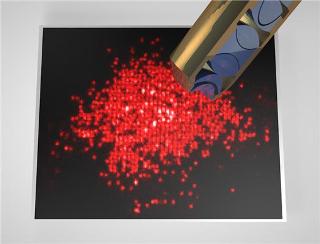Jan 5 2016
Today, quantum optical experiments provide methods to prove the rules that have been thought of and pressed into elegant mathematical equations in those days.
 Single atom resolved fluorescence image of a band insulator of fermionic lithium in an optical lattice. (Picture: MPQ, Quantum Many Body Systems Division)
Single atom resolved fluorescence image of a band insulator of fermionic lithium in an optical lattice. (Picture: MPQ, Quantum Many Body Systems Division)
In this regard, scientists in the Quantum Many-Body Division of Professor Immanuel Bloch at the Max Planck Institute of Quantum Optics have made a big step forward.
Scientists at MPQ observe “Pauli blocking” between fermionic lithium atoms in an optical lattice
The microcosm is governed by its own laws – the rules of quantum mechanics. They describe, for instance, the statistical behaviour of elementary particles. Electrons and all the other constituents of atoms belong to the group of fermions that are never allowed to share identical quantum numbers. This “exclusion principle” was formulated by the Austrian physicist Wolfgang Pauli in 1925 in order to explain the structure and the stability of atoms. Today, quantum optical experiments provide methods to prove the rules that have been thought of and pressed into elegant mathematical equations in those days. In this regard, scientists in the Quantum Many-Body Division of Professor Immanuel Bloch at the Max Planck Institute of Quantum Optics have made a big step forward.
The team around project leader Dr. Christian Groß demonstrated the first direct observation of “Pauli blocking”, a consequence of the exclusion principle. To this end, they cooled a cloud of fermionic lithium-6 atoms down to extremely low temperatures and loaded the particles into an optical lattice. Since identical fermions are not allowed to occupy the same lattice site each atom is supposed to find its own place. This was exactly what was observed in the experiment with the help of a quantum gas microscope that images atoms with single-particle single-site resolution. “Our success is the result of adapting our cooling and imaging methods that were developed for bosons, to the needs of fermions”, Christian Groß explains. “Our work opens a new avenue for studying quantum correlations in fermionic quantum matter, or to get a better understanding of phenomena such as quantum magnetism and superconductivity.”
Quantum statistics distinguishes between two fundamentally different kinds of particles. There are, on the one hand, the “sociable” bosons which condense into a single quantum state at zero temperature. On the other hand, there are the “solitary” fermions for which multiple occupation of a single state is forbidden. In their work with cold quantum gases scientists have a free choice: particles with integer spins are bosons, whereas fermions are characterized by their half-integer spin. Hence, what kind of statistics, i.e. what ‘social behaviour’ the atoms obey depends on the total number of their electrons, protons, and neutrons. If the goal is to simulate the behaviour of electrons in a solid crystal with atoms in optical lattices, fermions are, of course, the better approximation. However, in most experiments so far scientists have used bosonic particles since it is, for several reasons much harder to bring fermions down to the low temperatures required.
Now, by combining efficient cooling methods with high precision detection the team around Dr. Christian Groß has taken this hurdle in an experiment with fermionic lithium-6 atoms. At first, the atoms are cooled down and caught in a dipole trap. By applying several light-fields the scientists obtain a single plane with a couple of hundred atoms. Now an optical lattice – created by interfering laser beams – is superimposed. This lattice defines the “crystal geometry”, i.e. the sites where the atoms are allowed to settle down.
The most important and new step, however, was the modification of the quantum gas microscope developed a couple of years ago in the Bloch group. The scientists applied a special cooling method, originally developed to cool ions, to fermions in an optical lattice. Here the quantum mechanical oscillation states of an atom in a lattice well are manipulated in such a way that the atoms are driven into the lowest state, accompanied with a lower temperature.
At the same time photons are scattered at the atoms, causing them to light up like tiny nano light bulbs that can each be observed individually. A high resolution microscope objective images the atoms all at once, such that a photographic snapshot of the atomic gas is taken. The measurements show a rather flat distribution in the centre of the trap, with one atom per lattice site. “It is important that this distribution arises as a result of quantum statistics – i.e. Pauli blocking – only,” Ahmed Omran points out, doctoral candidate at the experiment. “Identical fermions repel each other; there is no other interaction at work.”
Due to the periodic order of atoms in a solid state crystal the energy levels of the electrons split up into “bands” of closely neighboured states. If the highest so-called valence band is fully occupied the electrons cannot move, therefore the material is an insulator. The quantum state of the fermionic lithium-system generated in the experiment represents an analogue to that state: the Pauli principle leads to a fully occupied valence band, i.e. to a suppression of conductivity, which manifests itself by a strong suppression of particle number fluctuations detected with the quantum gas microscope.
The new technique offers a variety of new possibilities for further experiments with quantum many-body systems made of fermionic atoms. For instance, modifications of the method will make it possible to manipulate even single fermions in the systems, leading to even lower temperatures. There a new antiferromagnetic order is expected to emerge that should be detected and characterized with the quantum gas microscope. Antiferromagnetism is a widely discussed candidate for the explanation of fundamental phenomena in superconductivity.